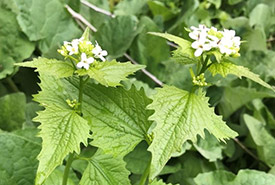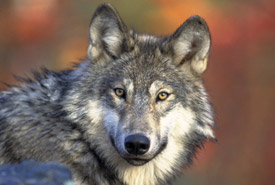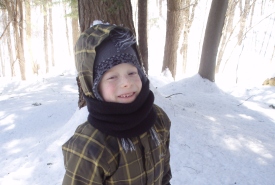Adventures in the night: My foray into astrophotography

Located on Plymouth's doorstep, Dartmoor National Park is a vast moorland known for its forests, rivers, wetlands and tors (rock formations). This photo is of Great Staple Tor with me in the foreground. (Photo by Esme Batten/NCC staff)
“Are we almost there?” I ask my new friend Matt as we wander along a sea cliff on the north coast of Cornwall, U.K., shivering, in search of our shooting location for the evening. Although by Canadian standards the evening was balmy at...
What happens to invasive species in the winter?

Second-year garlic mustard plant (Photo courtesy Invasive Species Centre)
With the change in seasons, invasive species may become out of sight and out of mind. But they always seem to come back every year. So where do they go in winter? Researchers are working to answer this question by investigating how invasive...
Nature's Olympians

Grey wolf (Photo by Gary Kramer, courtesy of USFWS)
With our dedicated Canadian athletes competing in the Olympic Winter Games, we at the Nature Conservancy of Canada started thinking about species that could step in for our Olympians, should they need a stand-in. These species would truly embody a...
Pics, or it didn't happen

A snow covered forest (Photo by Paula Noel/NCC staff)
The day after our first real snowstorm of the winter, I headed out to enjoy the woods near my home. At a brisk -10 C, it was the perfect temperature for hiking with the right gear on, but not an ideal temperature for my cell phone; I...
Diving into winter hibernation

Northern map turtle (Photo by D. Gordon and E. Robertson)
It’s official: winter has made its way across Canada, and isn’t going anywhere anytime soon. Humans layer up to brave the cold, and migratory birds make their way to warmer climates, but turtles have their own way of toughing out the...
The winter of my content

"Spike" hiking (Photo by Gayle Roodman/NCC staff)
One of the many joys of living in Canada is that we have four seasons. In southern Alberta, where I live, it’s not uncommon to have all of them in one day. Each season has its merits, but there’s something special about winter. Maybe...
Beginner's guide to winter tree identification

White ash bud and twig (Photo by Quinten Wiergersma, CC BY 4.0)
Many trees are easier to identify without their leaves. When you’re out for a winter hike, it may seem that there aren’t many clues to identifying the trees around you. Because trees are sporting bare branches, you might think they...
Take them to feel the forest: Winter sensory activities for kids

Snowshoeing in Parc de la Gatineau, QC (Photo by DJ)
I‘ve walked in the woods all my life, but it wasn't until I took young children with me that I noticed how fascinated they were with the variety of textures found in their surroundings. Kids can spend hours feeling, building, touching and...
Winter is for the birds

Prothonotary warbler (Photo by Bill Hubick)
When the temperature drops and fall colours give way to bare trees and snowy scenes, we tend to huddle up for the winter. Much like the natural world, we might prefer to take off to somewhere warm or hunker down indoors, to conserve our energy and...
8 tips for enjoying your winter experience safely

Spike hike on a relatively warm winter day. (Photo courtesy of Gayle Roodman/NCC staff)
Spending time in nature on a regular basis allows you to observe the subtle changes that happen daily. However, between seasons, the changes aren’t so subtle. In winter, low temperatures and shorter days force species to adapt. Deciduous...

